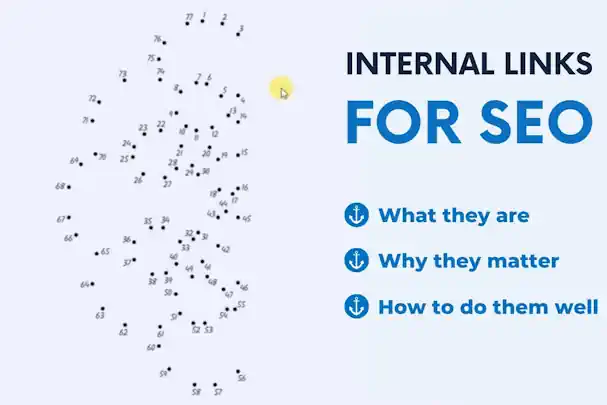Picture this: You’re in a labyrinth, trying to find the hidden treasure of digital success. You’ve got a map (SEO strategy) and a flashlight (content), but what’s missing? The breadcrumbs that lead you to your goal – internal links. In the sprawling domain of search engine optimization (SEO), internal link-building is the secret potion that can help propel your website to the top of search engine results pages (SERPs). So, grab your magnifying glass and let’s embark on a journey through the fascinating world of internal link-building!
Unveiling the Enigma – What Are Internal Links?
So, what exactly are internal links? Well, they’re like the signposts in a stately English garden – guiding visitors from one part of the estate (webpage) to another. In digital terms, an internal link is a hyperlink that connects one page of your website to another page within the same domain. It’s like creating a delightful trail of breadcrumbs that both users and search engine crawlers can follow.
These links serve multiple purposes. First and foremost, they aid in navigation, allowing users to explore related content effortlessly. Secondly, they spread link equity across your website, telling search engines which pages are more important. It’s as if you’re hosting a grand dinner party, and you’re ensuring that each guest (webpage) gets an equal share of the delicious SEO cake.
The Marvels of Link Juice – Why Internal Links Matter
Ah, link juice! It sounds like a refreshingly tasty beverage, but it’s the essence that fuels your SEO efforts. When you sprinkle internal links throughout your website, you’re passing on this precious link juice from one page to another. This link juice can boost the authority and ranking potential of the linked page.
Think of it as a savvy socialite introducing you to influential people at a soirée. The more you hobnob with these high-profile individuals (pages), the more your own reputation (rankings) rises. Internal links are your ticket to the glamorous world of high search engine rankings, darling!
Crafting the Perfect Internal Link Strategy
Now, it’s time to play the role of Sherlock Holmes, meticulously crafting an internal link strategy that will leave your competition in the dust. Start by identifying your cornerstone content – those pieces that are the crown jewels of your website. These are the pages, product categories, or blog posts you want to give a VIP tour to, so sprinkle internal links to them liberally.
Just like a skilled matchmaker, you want to connect pages with similar interests. If you have a blog post about the “Top 10 Tea Varieties,” don’t shy away from linking to your in-depth guide on “The Art of Teapot Collecting.” It’s all about fostering meaningful relationships (links) that make sense.
The Dance of Anchor Texts – A Delightful Elegance
Anchor texts are the enchanting ballroom dancers that guide you from one page to another. An anchor text is the visible, clickable text of a hyperlink, and choosing the right ones can be an art form. Imagine you’re at a dance, and the host (anchor text) announces, “Ladies and gentlemen, may I present to you – ‘The Best Scone Recipe’.” You’d eagerly follow that lead, wouldn’t you? Well, maybe!
Similarly, craft anchor texts that provide context. Instead of using generic phrases like “click here,” opt for descriptive ones like “Learn how to make the fluffiest scones” to entice both visitors and search engines. These links can also take the form of friendly buttons, which help them to stand out, and also makes them even more obvious as to where they are taking you.
As a further, less foodie-related example, you may want to learn more about link building, aside from just the internal link structure.
A Symphony of Hierarchy – Structure and Silos
In the majestic orchestration of your website, hierarchy and silos play pivotal roles. Just as a conductor arranges instruments into sections, you must organise your content into silos – groups of related topics. This creates a harmonious structure that allows for easy navigation and logical internal linking.
Imagine your website as a grand manor with different wings. Each wing houses a particular theme, and the hallways (internal links) guide visitors seamlessly from one room to another. The result? A delightful stroll through your digital mansion, with search engines applauding your impeccable arrangement.
The Mischievous Nofollow – To Follow or Not to Follow?
Enter the mysterious character known as “nofollow.” This little rascal, when added to an internal link, instructs search engines not to pass on link juice. It’s like inviting someone to a party but telling them they can’t bring any friends!
Nofollow links can be useful in certain scenarios – perhaps you want to guide users to a page without boosting its ranking. But be wary not to overuse them, for you don’t want to appear inhospitable to the search engine crawlers.
Summary
And there you have it! The enchanting tale of internal link-building for SEO, peppered with whimsy. Just as a cup of Earl Grey tea complements a plate of scones, internal links complement your SEO strategy, creating a symphony of navigation and authority that search engines and users adore.
So, the next time you’re navigating the intricate maze of digital success, armed with your map and flashlight, remember the magic of internal links. Craft them with care, lead your visitors on a merry dance through your digital estate, and watch as your website ascends the ranks of search engine glory. Cheers to your link-building escapades, old chap!
LOOKING FOR AN SEO CONSULTANT TO HELP BUILD YOUR WEBSITE INTERNAL LINK STRUCTURE?
If you are looking for an SEO consultant to help your business, advise or give hands-on help in ranking your website through internal link building and SEO, call Wiser IT today on 07941 783434 or fill in the contact form

